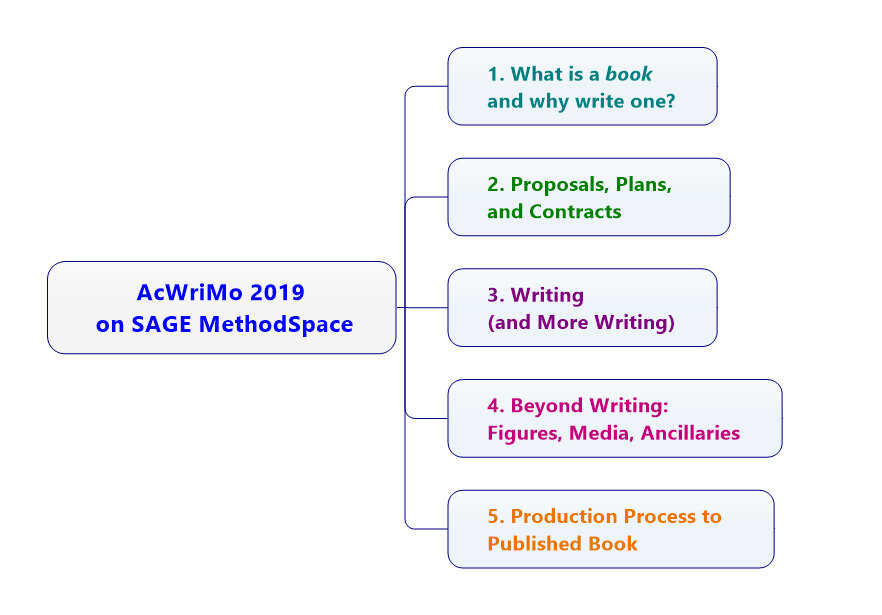Writing & Publishing Books: Getting Started
by Janet Salmons, Research Community Manager for SAGE Methodspace
Every November academic writers everywhere share goals, progress, and frustrations using the #AcWriMo hashtag. Academic Writing Month is also a great time to develop new skills and sharing resources. The 2019 AcWriMo MethodSpace focus was on all stages related to publishing books.
Thinking about writing a book?
Firs, think through the options for research-focused books so you can begin drafting a book proposal that will fit your goals - and the needs of your readers.

What is a book?
To begin with, let's contemplate what we mean when we discuss books. Like many words, the definition has changed, thanks to technology. Does the term book refer to something with a lot of pages, bound and encased in a cover? Or is a book an audio file I listen to on my phone? Or a graphic story I grasp from pictures? Is a book a series of chapters, outlined in a table of contents and read in sequence, or section read from a downloaded PDF file? Is a textbook a big heavy (and expensive) tome, or a website I log into to access readings and media?
As a writer, what do you think about in regard to form and delivery of this thing you call a book? Importantly, what do the readers you hope to reach expect from a book? Let’s look at some options, and define terms we’ll use throughout the series.
Type, Content, and Audience
Who are you trying to reach? Are you hoping your book will be adopted as a text, read by others in your field or discipline, or used as a how-to guide by professionals or practitioners? Do you expect it to be a reference book accessed through an academic library, or available to anyone at the local bookstore?
Handbook of research:
Reference book that provides in-depth foundations on the topic(s), with contributed chapters or sections
Primary readers: Academics and students
Scholarly book:
A research-based book.
Primary readers: Academics and students, some general-interest readers
Textbook:
A book designed for instructional purposes.
Primary readers: Students
Workbook:
A book that contains exercises or prompts to be completed by the reader.
Primary readers: Students, professionals, practitioners
Guide:
A practical how-to book.
Primary readers: Students, professionals, practitioners
Professional or trade book:
A book typically written for a non-academic audience, can focus on how to apply or use research findings
Primary readers: Professionals, practitioners
Size and Form
What is the ideal length for your book?
Small book: These books can range from 5,000 to 50,000 words
Monograph: Length dependent on content, typically shorter than a full-length book
Full-length book: Usually 70,000 words or more
Workbook: A book that allows readers to fill in templates, write or draw
Handbook or reference book: 1 or more volumes

Delivery
How do you want readers to access books? While e-books have been commonly available for scholarly and academic books, newer forms such as audio or graphic books are becoming more popular and will undoubtedly reach the academic market soon.
Print book
Electronic book
Is it sold and read as an entire book?
Is it sold and read as discrete sections or chapters?
Is it distributed in formats easily read on mobile devices?
Audio book
Graphic book
More Methodspace posts about writing and publishing books
Celebrate Academic Writing Month 2023 by getting organized! Find open-access resources to help you avoid being distracted by details and lost files.
Maria Lahman offers tips to help you hone your academic writing
Get ready for #AcWriMo! Find a checklist that will help you overcome obstacles that keep you from making progress with academic writing.
Need to brush up your skills, find a book for a course or a student? Here are some options from Sage for researchers who want to analyze qualitative data.
Even if it isn’t the book you pack for a beach getaway, this is a good time to review new texts for future course instruction. You might also find materials that can introduce new approaches and enhance your research skills. Find new titles about quantitative methods (and a discount code.)
Dr. Helen Kara and Dr. Janet Salmons discuss their experiences and strategies for planning and writing a new book edition.
Dr. Rennison won two awards for her innovative books. Hear about how she creates research impact.
Despite the warnings of digital doomsayers, academic book publishing remains dominated by print. That said, reader behavior has changed and continues to evolve. This is particularly true of how readers discover and read books and chapters. Rather than visiting a library or bookshop in person, readers of scholarly books start their searches online. For publishers, ensuring that books are prominent and visible in such searches is essential to encourage readership and drive citations.
Since I am advocating for ways to stay engaged with writing, drifting may seem a strange interlude. Yet, I find drifting to be a vital companion state to writing. For me, usually drifting occurs when I have set aside all devices and am absorbed in some wholly different task, such as gardening, chauffeuring or waiting for children, or simply watching birds congregate at the feeder.
What is a “scholarly voice” and how do I develop it?
Organize your writing so reviewers understand what you are saying.
Dr. Helen Kara discusses ways to use writing as a method - a valuable approach for independent or practitioner researchers.
Academic blogging- what is it and how can it be a part of your publication strategy?
Pause. Take a walk. Listen to your muse. Then you will be ready to write!
Want to edit a book? Think about your goals and editorial style, then make a plan!
Do you want to join or form a student writing group? See these tips from Maria Lahman
We featured two editors in a webinar about the stages of writing a book. View the recording for Write a Book! From Acquisition to Publication here.
The AcWriMo19 focus on MethodSpace was on all stages related to publishing books. First, what is a book? What kind will you write?
Questions to ask if you are thinking about editing a book.
How do you propose an edited book? Read this post for some steps.
Planning to edit a book? Learn about the stages.
If you are thinking about editing a book, learn about the action steps involved!
























Have a writing project that is languishing? Find practical tips for keeping it alive!